Wild Berkshire, Buckinghamshire & Oxfordshire
REVIVE OUR RIVERS
What we can do to save our precious waterways
THE GREAT ESCAPE
The best nature reserves to visit this spring


What we can do to save our precious waterways
The best nature reserves to visit this spring

How our latest project will create a green lung at the heart of our region


The troubled state of nature and our climate is no secret. That important 1.5-degree threshold has been exceeded for the first time, and we have a government hell bent on economic growth, seemingly at any cost – the sheer scale of development planned is staggering.
But all is not lost. As a member, you have invested your faith in us to restore nature across our region. Local action is important, and this is where we can create change for the better.
So I am delighted to share further details of a project that has been under development for some time. Our Reconnecting Bernwood, Otmoor and the Ray project will create a green lung at the heart of our counties, connecting fragmented areas of habitat to enable wildlife to not just survive but thrive and spread out into the landscape. It’s all very exciting! Turn to page 10 to find out more.
Leading a charity through the cost-of-living crisis, local council cuts and the short termism of our political system is incredibly challenging. We are not immune to those impacts and need to balance our income and costs like everyone else.
With more financial clout we can do even more, ensuring a truly wildlife-rich landscape throughout our region. Your support is vitally import and really makes a difference. Our Nature Recovery Fund is ongoing. So far, we have raised almost a quarter of the £3 million target, so there’s a way to go. Can you help us restore nature where you live? Visit bbowt.org.uk/sos if you can make a donation. All contributions, no matter their size, are hugely welcome.
As I hope you appreciate, you are truly essential to nature’s recovery, so thank you for being a member and supporting our work.

Estelle Bailey, Chief Executive
Wild Berks, Bucks & Oxon is the membership magazine for Berks, Bucks & Oxon Wildlife Trust
Contact 01865 775476, info@bbowt.org.uk
Membership 01865 788300, membership@bbowt.org.uk
Address The Lodge, 1 Armstrong Road, Littlemore, Oxford OX4 4XT
Website www.bbowt.org.uk
President Steve Backshall
Chair George Levvy
Chief Executive Estelle Bailey
you
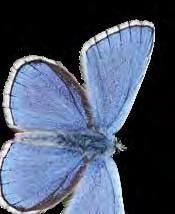



Wild Berks, Bucks & Oxon is brought to you by
Editor Benedict Vanheems
UK Editor Joanna Foat
UK Designer Ben Cook
Design Yorkshire Wildlife Trust Design Studio
Print CKN Print Ltd
Cover Mark Hamblin/2020VISION

A large-print version of Wild Berks, Bucks & Oxon (text only) is available on request. Call 01865 775476 or email info@bbowt.org.uk
Enjoy the extended version of Wild Berks, Bucks & Oxon online at bbowt.org.uk/publications

The best of the season’s wildlife and where to enjoy it on your local patch
Spectacular horizons of wild flowers and grasses sweeping across three of our nature reserves will make your heart sing. BBOWT has three Coronation Meadows, designated in 2013 to mark the 60th anniversary of Queen Elizabeth’s reign: Chimney Meadows alongside the River Thames in Oxfordshire, the Upper Ray Meadows in Buckinghamshire, and Moor Copse west of Reading.
These extraordinary meadows are now gifting seed through the harvesting and spreading of green hay to create new wildflower meadows nearby. This is helping to restore lost species-rich grassland, providing more food for pollinators as well as habitats for small mammals and birds.
SEE THEM THIS SPRING
Chimney Meadows: Follow the footpath signs from the car park to explore the wildflower-rich fields of this ancient landscape.
Upper Ray Meadows: The drier meadows are ablaze with wildflowers, butterflies and dragonflies. Bring binoculars to spot birds from the hides at Gallows Bridge Farm.
Moor Copse: One of our most charismatic wildflower meadows. Look out for butterflies such as the silver-washed fritillary.

Our Coronation Meadows are managed through traditional farming methods, including conservation grazing using rare breed livestock.
Your membership helps us restore wildflower meadows across our region. Thank you!
Dragonflies and damselflies are the descendants of insects that flew with dinosaurs.
The names of dragonfly and damselfly species – ruddy darter, vagrant emperor, and beautiful demoiselle – are part of the allure of these ephemeral flying insects. They zigzag across water, spreading or folding their colourful wings when they alight on plants. We see just the final beautiful stage of their lives as they seek a mate, breed, lay eggs and die.
Agile dragonflies have two pairs of strong, transparent or brightly coloured wings. Each wing is flexed separately to generate thrust and direction, turn sharply, fly forwards, backwards, up and down. Damselflies
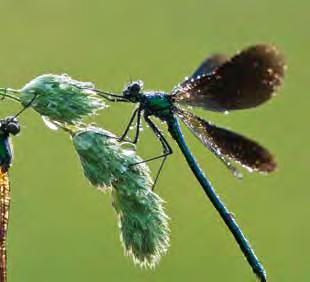

Each June we set the exciting 30 Days Wild challenge, inviting everyone to do one wild thing each day. Long midsummer days give time to be outdoors, watching birds, sitting beside a pond or painting flowers. Visit bbowt.org.uk/30-days-wild to sign up for a free pack of inspiring ideas and fun information to help you, your family and friends get started. There are packs for schools too.

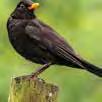
Visit Decoy Heath this summer to see many of the 23 species that breed around the shallow pools we’ve created. The willow emerald damselfly is one of the rare species recorded here: bbowt.org.uk/decoy-heath
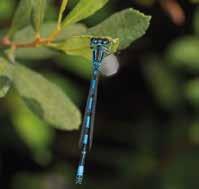
have a fluttery flight and fold their two pairs of wings back when they perch. Volunteers recorded increased numbers of the endangered southern damselfly at Parsonage Moor, where fenland habitats have been created for these aquatic insects. At Dry Sandford Pit we recorded the willow emerald damselfly for the first time last year. This dark metallic green damselfly favours sites where it lays its eggs in the bark of willow and alder trees overhanging still water. It is a recent arrival in the UK, possibly due to climate change.
DID YOU KNOW?
Water world: Dragonflies and damselflies spend 90% of their lives as nymphs under water, some for up to five years.
Numbers game: There are more than 40 species of dragonflies and damselflies in the UK.
Ancient: Dragonfly and damselfly fossils are found in rocks from the Carboniferous period from more than 300 million years ago.

Spring is a thrilling time as nature stirs from its winter slumber.
Next leap
Froglets leap out of the ponds where they transformed from eggs in clumps of spawn into tadpoles and grew their long legs.
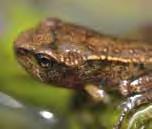
Bursting buds
Fresh green unfurling beech leaves bring bright new colour to woodland and dappled shade for summer walks.

from eggs laid among nettles to spin their webs and feed on the leaves.

Wake early to hear the best tunes of the day. Robins first, followed by blackbirds and thrushes, then wood pigeons, wrens, dunnocks, blue tits and finches.

The Thames Valley is a hot spot for stag beetles. Look out for the UK’s largest beetles, with antler-like jaws flying unsteadily at dusk, or crawling to find a mate.





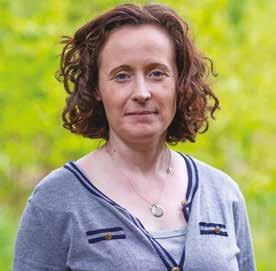
In the first of a new series we talk to Laura Rushby, Head of Volunteering.
What sparked your love of wildlife?
I was fascinated by insects when I was little. Then when I was about nine, I started a nature club with a friend. We made badges and invited all the kids on our street over on a Saturday afternoon. I remember going on bug hunts in the garden, making little homes for wildlife, and coming home with ‘treasures’ after adventures in the woods.
What’s your favourite nature reserve? Each reserve is special for different reasons, from watching my first kingfisher at CS Lewis Nature Reserve to sharing the excitement with my little one when he found candlesnuff fungus at Woolley Firs. But I’ll never forget visiting College Lake for the first time – just wow! And every time I visit, I discover something new, from orchids and lizards, to learning about the history from one of our brilliant volunteers. It’s definitely a special place.
What is the best part about your role?
As Head of Volunteering, I’m passionate about the positive power of volunteering, both for those who volunteer and for BBOWT. From my experience, when you empower people to work together to achieve a shared mission, there’s nothing greater. Small acts for nature, multiplied by millions of people, can transform wildlife in our three counties and beyond.
Where can we find out more about volunteering?
There are volunteer opportunities available across BBOWT, on our reserves and in communities, from conservation work to visitor welcome, learning and events. Join in to help nature thrive! Visit bbowt.org.uk/volunteer or email volunteering@bbowt.org.uk with any questions. Or read more about some of our inspirational volunteers at bbowt.org.uk/volunteer-awards
The Langford Community Orchard Group in Bicester is one of a number of groups BBOWT is supporting though our Community Network. Since forming in 2011 the group has cleared and maintained the orchard on behalf of Bicester Town Council, offering fruit for the community and a haven for wildlife. The orchard is a fantastic place to wander and enjoy some peace and quiet.
Volunteers meet on the first and third Sunday of the month. Over the years they have planted fruit trees, bushes, hedgerow and wild flowers. Dead hedges offer hidey holes for wildlife, while members have carried out surveys of the wild flowers and butterflies. The group has organised courses on coppicing, scything and pruning within the orchard. Every October they host an Apple Day where people can watch the group’s apple press in action then sample the fresh apple juice for themselves.
BBOWT’s Community Network offers support, advice and training to local groups making a difference for nature. If you or your group would like to know more about the network, please visit bbowt.org.uk/teamwilder-community-groups

#TeamWilder
Discover more ways to get closer to nature. Join in at bbowt.org.uk/ team-wilder
Rachel Reeves promised to be ‘Britain’s first green chancellor’, but her recent announcements on planning and airport expansion risk undermining hard-won efforts to protect nature – the very foundation on which growth is built. BBOWT is part of a coalition of Wildlife Trusts across Southeast England expressing strong opposition to the proposed expansion of Heathrow, Gatwick, and Luton airports. While we recognise the importance of economic growth, the Trusts argue that such expansions come at the expense of sustainable development, compromising the UK’s climate and
biodiversity commitments.
“We must not allow short-term gain to inflict long-term damage to the economy, health and security of future generations. The climate crisis is the biggest threat our planet and all life on it faces,” says Chief Executive Estelle Bailey.
We are also deeply concerned about the announcement of significant new development along the Oxford to Cambridge Growth Arc, including road upgrades and new towns. We urge development plans to put nature, environmental carrying capacity and placemaking at the heart of decision making.

Work to improve conditions for wetland birds and other wildlife has just been completed on the Upper Ray Meadows.
The Upper Ray Wetland Restoration Project saw the creation of more than 3km of wader scrapes (shallow scrapes in the ground that hold onto flood water for longer). These will benefit breeding curlew, redshank, lapwing, as well as overwintering wildfowl such as wigeon and teal.
Anti-predator fencing has secured an area of 22 hectares for the breeding waders, while the replacement of stock fencing ensures more of the floodplain meadows can be safely grazed – essential
for maintaining wild flower diversity.
The project was awarded a grant from the FCC Communities Foundation as part of the Landfill Communities Fund.


Keep up to date
Visit bbowt.org.uk/ newsletter to sign up for our latest news, delivered to your inbox.
January’s count of brown hairstreak eggs reveals a stable population of this rare butterfly. The team of 15 volunteers and staff counted 43 of the 1mm-diameter eggs as they scoured the blackthorn hedges at Asham Meads, Oxfordshire. The 33% increase on the 29 found in 2022 is testament to the Trust’s hard work creating and maintaining important habitat.

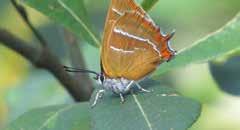
Greenham and Crookham Commons have a rich history. Once the site of a military air base, Greenham Common’s airfield was reopened to the public in spring 2000 following decades of military occupation. Join us on 8 April, 25 years on, to celebrate this landmark anniversary. Find out what’s planned at bbowt.org.uk/greenham25
March marked the start of the groundnesting bird season, when species such as nightjars, skylarks and Dartford warblers nest on the ground or in low-growing shrubs. Seasonal wardens at Greenham & Crookham Commons and Snelsmore Common Country Park will be reminding visitors to remain on the paths and keep dogs under close control at this time.

BBOWT is well known for reversing nature’s decline, and businesses can be a part of that thanks to our Investors in Wildlife programme.
Our newest Investors in Wildlife members include English Provender Company Ltd, Iron Mountain Data Centers, and Prime Coffee Suppliers – a very warm welcome to you! Thank you too to those renewing their membership: A Menarini Diagnostics UK, Oxford PharmaGenesis Ltd, QuickMoveNow,
St Anne’s College Oxford, Tieva INC, and The Renegade Brewery. To find out more about how your business can act for nature, please contact us at partnerships@bbowt.org.uk


Huge thanks also go to the staff at Novuna Vehicle Solutions for their hard work at five Wild Work Days over the last two years. The teams helped us maintain 1.4 hectares of heathland at Snelsmore Common, benefiting groundnesting birds and reptiles. They also constructed 30 metres of pathway at Hosehill Lake, ensuring visitors can enjoy the lake without disturbing wildlife. Both reserves are home to rare and diverse species, so these Wild Work Days have achieved great outcomes for nature.
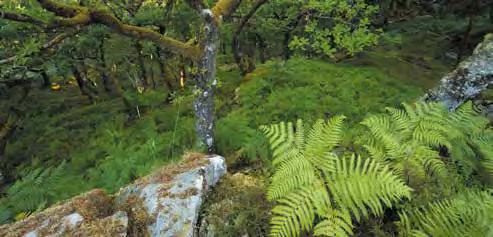
Temperate rainforests will feature in The Wildlife Trusts’ garden at this year’s RHS Chelsea Flower Show
Discover how The Wildlife Trusts are helping wildlife across the UK

Cumbria Wildlife Trust is celebrating seal pups born at its coastal nature reserve at South Walney near Barrow for the 10th year running. The growth of the grey seal colony from single figures in the 1980s and 90s to over 500 since breeding began in 2015 is a great conservation success story. wtru.st/Cumbria-seal-pups
The smallest beetle in Europe has been discovered by Leicestershire and Rutland Wildlife Trust. The tiny beetle, Baranowskiella ehnstromi, found at Rutland Water Nature Reserve, measures just 0.4mm in length and feeds on spores of a bracket fungus. This is the third British record for the species and the first outside East Anglia.
wtru.st/Rutland-beetle
The Wildlife Trusts are bringing rainforests to RHS Chelsea Flower Show!
The British Rainforest Garden, designed by award-winning Zoe Claymore and sponsored by Project Giving Back, will evoke the lush, wet woodlands that once swathed vast areas of the west coast of the British Isles. By bringing the enchantment of temperate rainforests to Chelsea, we hope to inspire people to support the restoration of this threatened habitat and show how
nature-friendly gardening can help British wildlife thrive.
Inspired by the ambitious 100-year mission of The Wildlife Trusts and Aviva to bring rainforests back to the British Isles, the garden will share the story of this precious habitat that once blanketed a fifth of our country and is now so rare that it only covers about 1% of the land. Restoring them will create beautiful places for people to enjoy, help wildlife recover and tackle climate change.

15 pine martens were released at secret locations on Dartmoor after a 100-year absence. After two years of meticulous planning and consultation with local communities, the reintroduction, led by Devon Wildlife Trust and seven partners, is an historic step in the restoration of the region’s woodlands and wildlife. wtru.st/pine-martens-return
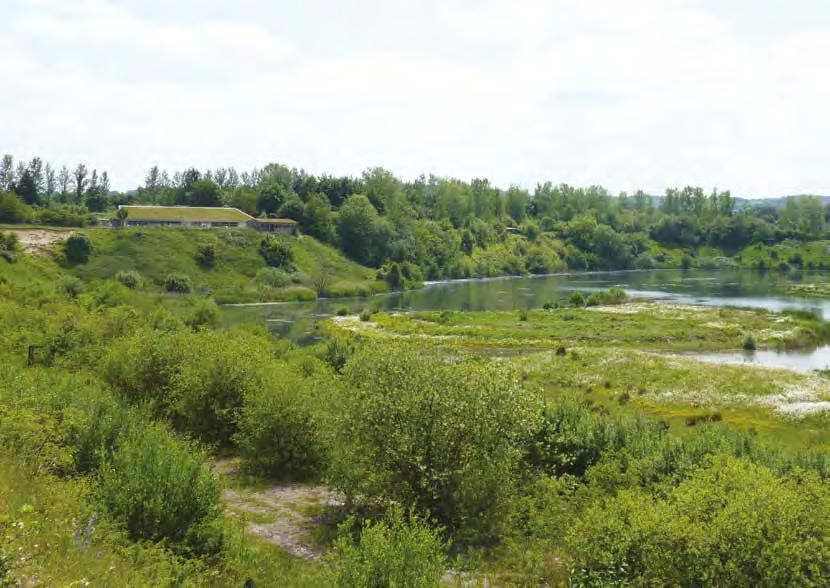
College Lake
Discover some of the UK’s wildlife national treasures with family and friends as these BBOWT reserves reach their brilliant best.
Postcode HP23 5QG
Great for... Wading birds
Size 67 hectares
Map ref SP 935 139 what3words broadens.ends.pebbles
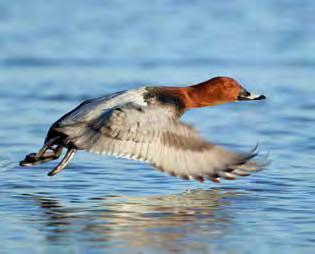
Until 1991, College Lake was still a working quarry. Then, in a joint project with Castle Cement, we transformed the site into our flagship Buckinghamshire reserve. It now boasts more than 1,000 species, an eco visitor centre and cafe.

Among the wildlife highlights is the huge variety of birds that descend onto the lake to breed each spring and summer, attracting experts and families alike.
In spring, lapwings with iridescent feathers and stylish head plumes set up territories on the islands and perform their acrobatics over the water. Redshanks with bright orange legs, oystercatchers with long crimson beaks, and little ringed plover soon join them. As summer arrives, common terns breed on the nesting islands and their loud screeching calls can be heard across the reserve.
Elsewhere summer wonders abound in the chalk grassland. College Lake is one of the few places where you can enjoy wild cornflower, mauve corncockle and deep red pheasant’s-eye, all part of an arable weeds project we established to save traditional cornfield flowers from extinction. They support a range of insects, including rare butterflies such as the small blue.
Another summer highlight is our wasp spiders: these large yellow-and-black striped arachnids, a recent arrival to the UK from the Continent, hang out in their webs in long grass, waiting for prey.
To explore the full range of habitats, why not try our two-mile circular Wildlife Walk – just follow the lapwing waymarkers.

College Lake is one of the most important sites in the region for rare wading birds, but we can only maintain this fantastic habitat with your support.
Postcode RG8 0EP
Great for Pasqueflowers and orchids
Size 4 hectares
Map ref SU 616 796 what3words meanings.tutorial.
chairs


Postcode OX13 6JW
Great for Carnivorous butterworts
Size 6 hectares

The panoramic view of College Lake never ceases to lift the spirits. The nearest lake is full of ducks and geese throughout spring and early summer. On my last visit there were cormorants, pochards and much more. Spring is also a good time to see the new growth of chalk plants that cover the reserve, especially in our corn flower fields.
At the far end of the reserve, we hang birdfeeders. I always pause here and enjoy the wildlife. Nearby is a path leading into the woods, it takes me to a pond where I watch the dragonflies.” Bernard Warner, volunteer and Trailside Ambassador at College Lake
Got a favourite nature reserve? Tell us about it! Email info@bbowt.org.uk with the subject heading ‘My wild escape’.
Many BBOWT nature reserves are home to extremely rare plants like monkey orchids which can be hidden by long grass, so please keep to the footpaths at all times.
One of the jewels in BBOWT’s crown, the grassy hillside at Hartslock with its stunning views over the Thames is also home to the charismatic pasqueflower. Steeped in legend, it flowers at Easter so is also known as the ‘anemone of Passiontide’. Look

Map ref SU 461 997 what3words waltzed.trams.shaky
Hidden in woodland near Abingdon, Parsonage Moor is a rare example of precious wild fenland. Among the species that thrive in the wet sphagnum moss is one of the UK’s insectivorous plants, the butterwort.
pink flowers in May. Southern marsh orchid and the nationallyscarce narrow-leaved marsh orchid thrive alongside them in the damp environment.
The site is also excellent for birds and insects. Look out for the dayflying scarlet tiger moth, dragonflies and the rare southern damselfly.
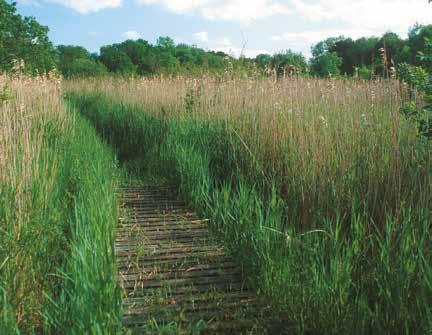
Parsonage Moor
Make the most of spring on one of our carefully curated circular Wild Walks. There are ten to choose from across all three counties. Find a Wild Walk near you and download the route instructions at bbowt.org.uk/wild-walks
Our latest project will ignite long-term landscape and species recovery while creating a green lung at the heart of our counties. Head of Landscape Recovery Charlotte Newberry shares our exciting plans.
Covering more than 300km2 between the major urban areas of Oxford, Bicester and Aylesbury, the Bernwood, Otmoor and Ray (BOR) region is home to nationally important wetlands, ancient woodlands, medieval royal hunting forest, and water meadows. It includes medieval claypits and pottery kilns, 24 Sites of Special Scientific Interest (SSSI), 83 Local Wildlife Sites, as well as eight BBOWT nature reserves. Its condition ranges from pockets that are well-managed and conserved, to polluted waterways, intensively farmed land, and expanding urban areas.
BOR also provides critical habitat for a long list of important species, some of which are nationally rare. These include Bechstein’s, Brandt’s, whiskered and barbastelle bats, all five species of

hairstreak butterfly, white admiral and purple emperor butterfly, breeding curlew and lapwings, the last recorded pair of breeding nightingale in Oxfordshire, noteworthy plants such as great burnet and truly rare species such as true fox sedge. Yellowhammer, bittern, redshank, marsh harrier, snipe, yellow wagtail, great crested newt, otter and many more species call the BOR landscape home.
The region faces numerous threats, from invasive non-native species and damaging farming practices to huge development pressure from local housing and large-scale, nationally significant infrastructure projects such as HS2.
In response to these threats, we have been developing a strategic landscapescale project to conserve important heritage and create a nature-rich ‘green lung’ between Oxford, Bicester, Aylesbury and Milton Keynes. Facing a global nature and climate crisis increases the urgency
for large projects like this to give species space to move across the landscape and to kickstart nature’s recovery in priority local and regional areas.
Reconnecting Bernwood, Otmoor and the Ray (RBOR) is an ambitious landscape-scale partnership to restore, reconnect and rediscover this diversebut-threatened rural landscape. The RBOR project was developed following a feasibility study commissioned by Buckinghamshire Council, which built momentum for action in the area. Development funding of more than £500,000 has been awarded by The National Lottery Heritage Fund (NLHF) to help the partnership progress plans to autumn 2027 when it will apply for a full National Lottery grant of more than £3.5 million to deliver the project over the next five years.

Activities will be spread across three themes. Our Nature Recovery theme will restore and create habitat to tackle fragmentation, revive threatened species, and enhance rural communities. The People and Nature Connections theme will engage disadvantaged communities with nature, strengthening social bonds and developing new skills. While the Enhancing Greenspaces theme will identify solutions to balance the needs of people and wildlife and improve accessibility and use of local greenspaces.
Each theme comprises a range of activities that complement each other with the aim of reinvigorating cultural and natural heritage throughout the BOR region, while supporting environmental, social and economic development.
The initial development phase will concentrate on pulling together further evidence on the need for action, addressing gaps in knowledge, engaging the people who live, learn, work and seek recreation across the BOR landscape, and providing a sound foundation for the delivery phase that follows.
The final activities in the five-year delivery phase will be refined during development and are likely to include actions such as hedge planting, wetland and pond creation, a programme of work experience opportunities, educational interpretation signage and access improvements.
RBOR is a partnership between BBOWT, Butterfly Conservation,

The delivery phase of the project is likely to include actions such as wetland creation
Community Impact Buckinghamshire, Design Historian Dr Helena Chance, Earthwatch Europe, Floodplain Meadows Partnership, Freshwater Habitats Trust, Ministry of Defence (Bicester Garrison), Newt Conservation Partnership, RSPB, and Wild Oxfordshire. The project is also supported by the Ray Farmer Cluster, Bucks and Milton Keynes NEP, Oxfordshire LNP, OxCam Pan-Regional Partnership, Natural England, and the Environment Agency.
The varying purposes, skills and experience of the organisations involved only serve to strengthen the RBOR Partnership. Some of the partners are already working together across the area – for example BBOWT and the RSPB have shared knowledge and experience to deliver projects on their individual landholdings within the project area for many years.
Partners understand that conserving heritage and supporting nature recovery
This funding provides us with an excellent opportunity to harness the momentum created in recent years and drive forward the recovery of nature in an area known for its iconic curlew and black hairstreak butterflies.
Learn more about this exciting project at bbowt.org.uk/ reconnecting-bernwood-otmoor-and-ray
The Reconnecting Bernwood, Otmoor and the Ray vision is for land to be well-managed for nature while remaining productive; we want to see local agricultural businesses thriving. Over time we will protect, restore and enhance this iconic landscape, its key habitats and the species found here. We will achieve this by harnessing a range of new funding mechanisms and sustainable income streams based on the positive benefits wildlife and nature in the region can offer people, communities and the environment.
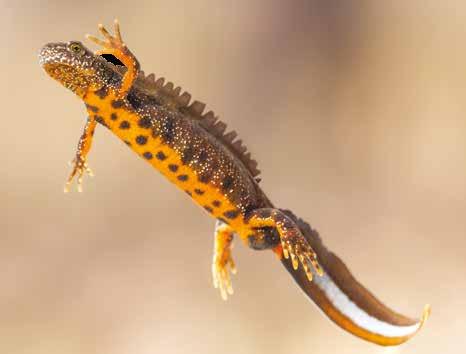

Help nature recover
Support our work to revive local rivers. Donate to our Nature Recovery Fund at bbowt.org.uk/SOS or call 01865 788300.


The strain our waterways are under is well documented, but it isn’t too late to turn things around – and you can help, says Planning and Policy Officer Holly Gray.
Rivers are the arteries of the planet, but it’s news to no one they are in an appalling state. Just 15% of English rivers meet good ecological health standards and not a single stretch is in good overall health.
Chalk streams should be the jewel in the crown of our waterways. They are one of the rarest habitats on Earth and
we are lucky to have 80% of them right here in Southern England. These rivers should be crystal clear and bursting with life, yet they’ve been pushed to the limit. Despite their rarity, just 11 British chalk streams have any legal protections, and these often fall short. If any rivers should be protected it should be our chalk streams, yet even they have been failed.

Development: For year rivers have been straightened, obstructed or had their flow changed. Buildings have encroached onto watercourses, while riverbank habitats have been lost and damaged. However, when rivers are returned to their natural form it is better for wildlife and people.
Abstraction: We take too much from rivers and use far more than most of our European neighbours, averaging 146 litres of water every day. This is why around 15% of rivers and 27% of groundwaters are over-abstracted. As climate change exacerbates droughts, demand will start to exceed supply, and rivers will end up running dry.
Pollution: Despite growing awareness of the sewage scandal, rivers continue to be polluted. In the first week of this year, raw sewage flowed into the rivers of Berkshire for more than 300 hours. During Storm Bert, more than 50 treatment works discharged sewage across Oxfordshire. Sewage was pumped into Buckinghamshire’s iconic River

Chess chalk stream for over 2,500 hours in 2024.
Nutrients from intensive agriculture and land management choke rivers. Chemicals from urban runoff, industrial pollution and elsewhere have resulted in no rivers in England being in ‘good’ chemical health and wildlife pays the price. Research has found that UK birds, fish and otters contain toxic ‘forever chemicals’.
What can be done?
Solutions to revive our rivers benefit people and wildlife alike. Leaving space for nature alongside a river – a ‘buffer’ – is hugely important for protecting watercourses from direct harm. Buffers work best if they are restored to a more natural state. Tree planting along a river, for example, can prevent soil erosion, cast shade to reduce warming, and reduce flooding.
Nature-based solutions such as restoring wetlands and floodplain meadows and installing sustainable
Live nearby? Why not join the Friends of Chimney Meadows volunteer work party. Volunteers meet fortnightly to complete a range of tasks. Full training is given and you will meet friendly, likeminded people. For details visit bbowt.org.uk/chimney-meadowsvolunteer-work-party
drainage systems (SuDS) help with flooding and drought, while slowing the inflow of pollutants. Moreover, areas become more climate resilient and nature-rich, in turn improving river health and our own wellbeing.
How you can help
You can help our precious rivers. Start by reducing your water use. This doesn’t just mean shorter showers but fixing any dripping taps or leaking toilets to reduce demand. Install a water butt to collect rainwater and, if you’re lucky enough to have a garden, include more vegetation (ideally native) to act as a natural sponge, easing flood risk. Avoiding chemical fertilisers and pesticides reduces the impact on local waterways.
Many MPs are already working hard to tackle river pollution, but the more people ask their MP to push for more protections and nature-based solutions, the more MPs will. Write to or email your MP or arrange a meeting to discuss the issue. Focus on why you care and what you’re asking for; make it personal and local. Mention our Save Our Chalk Streams campaign, which calls for protections such as introducing 50m buffer zones, defining chalk streams and their catchments as ‘irreplaceable habitats’ under planning rules, and encouraging parallel investment in water supply and treatment infrastructure in planning conditions. Find out more about the campaign at bbowt.org.uk/ save-our-chalk-streams
Many local community and volunteer
Working together in the Upper Thames
Our Upper Thames Living Landscape covers much of the area along the Thames from Lechlade to Northmoor in west Oxfordshire. Within this area we are working with local farmers to discuss ways to make their farms both more sustainable and financially resilient. The Upper Thames Farmers’ Cluster shares best practice through regular networking events and aims to drive change for the benefit of people and the natural world.
Funding through agri-environment schemes will enable farmers and landowners to create buffer strips immediately next to rivers to reduce river pollution. Converting arable fields to pasture reduces soil runoff during times of flood, keeping rivers cleaner and minimising the flood risk downstream.
Other practical measures include fencing livestock out of rivers where they might otherwise trample delicate riverbanks. At Chimney Meadows, for example, cattle no longer drink directly from the river but instead use special, self-activated pasture pumps, allowing riverside vegetation to recover and thrive.
groups are already taking action, whether water testing, surveying, campaigning or organising river clean ups. See if there’s a group near you; if there isn’t you could always start your own! Our website offers a community toolkit including starter resources and free community network online events and training. Head to bbowtcommunitytoolkit.org
Our rivers suffer an onslaught of threats, but nature has the potential to recover. Take the water vole, Britain’s fastestdeclining mammal following years of habitat destruction and predation by invasive American mink. On our patch water voles are reappearing, with activity up 78% from 2008 to 2018 thanks to BBOWT’s Water Vole Recovery Project. The fate of rivers isn’t sealed. With enough help, the lifeblood of our landscapes can thrive once more.
Easter’s nearly here, with some fantastic child and family events to look forward to. From fully supervised Day Camps to exciting trails, pond dipping and lots of other fun-filled activities, there’s plenty to keep the whole family amused! We will also be celebrating the 25th anniversary of Greenham and Crookham Commons’ reopening; together they form the largest continuous tract of open heath in Berkshire. Join us there on Tuesday 8 April to explore a pond or participate in a trail and experience this stunning site first hand. All events must be booked in advance.
For nature-loving children and teens we run our regular monthly wildlife clubs: Young Rangers, Teen Rangers and, for the little ones, Nature Tots.
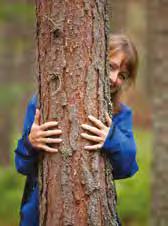
Forest Bathing
Sun 6 Apr, Sun 4 May, Sun 1 June & Sun 6 July, Windsor Great Park
Monthly event led by local Forest Bathing Guide Calvin Silvester. Immerse yourself in and connect with nature by utilising your senses. (Coming soon to College Lake too!)
Pond Dipping for Beginners
Sat 12 Apr, College Lake
Explore our wildlife ponds and discover the creatures living within.
Willow Obelisks for Beginners
Thurs 24 Apr, Sutton Courtenay Environmental Education Centre
Learn basic weaving techniques while making a garden obelisk to take home.
Highlights from our busy events diary. For full and up-to-date listings or to book visit bbowt.org.uk/events

Birds and a Brew
Fri 25 Apr, Weds 14 May & Fri 27
June, Nature Discovery Centre
Join us for a brew, a talk about birds and nature, and a walk to see what we can find.
Watercolour Workshop
Fri 2 May, Nature Discovery Centre
Explore the delights of watercolour painting in this friendly class for beginners.
Introduction to Bats
Weds 7 May, Windsor Great Park
Learn about bats, starting in the classroom then on a walk through the surrounding woodland.
Tree and Shrub Identification
Sat 10 May, Sutton Courtenay Environmental Education Centre
Identify a range of trees in their leafy summer state with expert James Warren.
Bats for Beginners
Weds 14 May, Wolley Firs
Join a bat expert on this talk and night walk to gain insights into these fascinating creatures.
Crafting a Future
Sat 17 May, Sutton Courtenay Environmental Education Centre
Community crafting session exploring environmental hopes and concerns, and what we can do to help.
How to be a Citizen Scientist
Sat 31 May, Sutton Courtenay Environmental Education Centre
Learn to be a citizen scientist using your phone to record butterflies and dayflying moths.
Dawn Chorus Walks with Breakfast
Sat 12 Apr, Sutton Courtenay Environmental Education Centre Sun 27 Apr, Nature Discovery Centre Sun 4 May, Woolley Firs Fri 9 May, Windsor Great Park
Sat 10 May, College Lake
Experience nature’s greatest symphony on one of these magical early morning walks!
Spoon Carving for Beginners Sat 31 May, Sutton Courtenay Environmental Education Centre
Learn to carve your own spoon with local carver David Knight.
Plant Galls and Leaf Miners
Sat 21 June, Woolley Firs
Expert Martin Woolner guides us into the often-hidden world of galls and leaf miners.
Bat Walk
Weds 4 June & Weds 2 July, Windsor Great Park
Join us for a walk using bat detectors to locate and help identify bats.
Botanical Monoprinting Thurs 5 June, Windsor Great Park
Be inspired by colour, shape and texture while creating artwork to capture the season.
Early Morning Walk
Fri 6 June, Sutton Courtenay Environmental Education Centre
A tranquil stroll followed by a wild breakfast on our beautiful nature reserve.
Nature Journalling Sat 7 June, Sutton Courtenay Environmental Education Centre


Liz Bonnin
@lizbonnin
I’ve been incredibly lucky to have had wildlife encounters that left me feeling deeply connected to nature. Some of the most memorable were in the Galápagos Islands. This remote, volcanic archipelago and its nutrient-rich waters have produced a magnificent abundance of life. Marine iguanas, fur seals and blue-footed boobies are entirely unphased by your presence here, so you feel like part of nature, not just an observer. In the water, I’ve spent hours playing with enigmatic sea lions as they invite you to chase them.
In the UK, one of my favourite wild places is Loch of the Lowes in Scotland – a truly magical place. For me it’s just as thrilling to see signs of beavers around the Loch, from coppiced vegetation to beaver chips, as it is to see them with my own eyes. It’s wonderful to witness these crucial ecosystem engineers recovering here and across the UK, after being hunted to extinction in the 16th Century.
But in my work, I’ve also seen how nature is bowing under the pressures of the modern world. I’ve reported on mile-long rafts of waste flowing down the Citarum River in Indonesia, made up of plastic sent ‘away’ by the West, and of thousands of sachets sold by global corporations – despite developing countries having no recycling infrastructure to deal with it. This was one of the most eye-opening moments of my career. Our unrestrained cycles of production and consumption in the global north, and our throwaway culture, are all destroying nature, that we need to survive.
Every species on earth has evolved over millions of years to carry out a function that maintains the health of ecosystems. And ecosystems, in turn, keep the planet healthy,
as part of the interconnected web of life. We humans have a role to play too, but many of us have become so disconnected from nature that we’ve forgotten this simple truth.
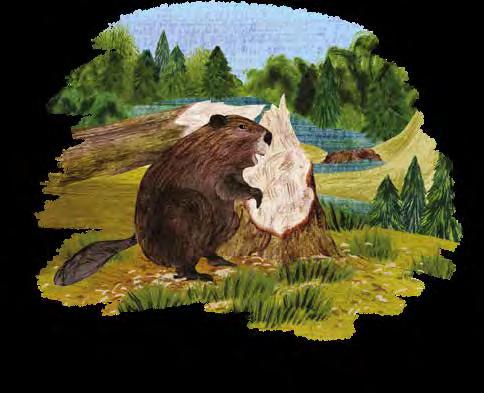
To turn things around, we must place nature at the heart of every decision, across all sectors of society. It’s encouraging that ecological economists are working to transform our economic model, so that nature and societal well-being are prioritised above profits. I’m also bolstered by the traditional ecological knowledge of indigenous communities, who live in harmony with nature. This crucial knowledge system, combined with western conservation practices, can deliver better, collaborative outcomes for people and nature.
Collaboration is our superpower, and this is equally true of The Wildlife Trusts. Our collective strength as a federation of 46 Wildlife Trusts knows no bounds! The more we collaborate and combine our knowledge and experience, the faster the ripple effect of change can flow. As part of our community, you can play a very real part in the change our planet needs, by sharing our stories, supporting our campaigns and volunteering with us. Lastly, perhaps most importantly, in these challenging times, my advice is to take a break from the news and get outside. Notice the sunlight through the trees, the sound of birds, and breathe. Connect with nature and everything else follows.
In late 2024, Liz Bonnin interviewed Nemonte Nenquimo, a climate leader who has dedicated her life to defending indigenous ancestral territory and cultural survival in the Amazon.
Watch the interview over on the Wildlife Trusts’ YouTube channel: wtru.st/Liz-Bonnin-interview
The UK Government has officially opened the door for licensed beaver reintroductions into the wild! These ecosystem engineers will help restore rivers, boost biodiversity and reduce flooding. For the first time, applications to release beavers into English river catchments will be accepted. Read our vision for their return: www.wildlifetrusts.org/ saving-species/beavers
Liz Bonnin is an explorer, naturalist and The Wildlife Trusts’ President. She is best known for documentaries including Galapagos, Wild Alaska and Blue Planet Live. Liz’s career has taken her around the world, studying animal behaviours and shining a spotlight on important environmental issues.

Boosting the wildlife in your garden couldn’t be simpler or more exciting. What you need is a garden pond. Believe me you won’t regret it, says the BBC’s Justin Rowlatt.
There’ll be a little digging. Just over a metre is good. All the wonderful pond creatures that are going to make their home in your garden need somewhere to shelter away from winter ice.
Then you’ll need a pond liner, gravel, some native pond plants and aquatic compost bags. Then you just fill it with rainwater and wait. This is when the magic happens.
During the first week or so your pond will go a sickly shade of green as algae makes itself at home. If you’re lucky, you’ll get your first creature by the third week. Mine was a hoglouse, a watery cousin of the woodlouse.
Next came mosquito larvae. I had loads, wriggling beneath the surface. But don’t worry, they are the lure that
is going to tempt in other creatures for whom mosquito larvae are the tastiest of treats.
The nymphs of dragonflies and damselflies can’t get enough of them. Frogs and newts love them too. And if any do manage to hatch into actual mozzies, they’ll be dinner for swallows, swifts and bats.
What you’ve created is an entire ecosystem, an intricate food web. The algae is food for the insects who are food for the frogs who are food for hedgehogs. You get the picture.
When you wonder why you are spending so long just staring at your new pond here’s the answer: what is unfolding before you is nothing less than the story of life on Earth.


The bottom of the food chain. Without it your pond would be a lot less enticing.
Hoglice are an aquatic relative of the woodlouse. They are once of the oldest animal species on earth at more than 300 million years old.


Rat-tailed maggot
Think of maggots but with snorkels attached to their bums. Except because rattailed maggots are aquatic, they mutate into beautiful hoverflies.





Marsh marigolds
Think buttercups but bigger and framed by dramatic dark foliage. They provide a hiding place for frogs and nectar for insects.
This pretty flag iris is the only aquatic iris native to the UK, so worth including.
Hornwort
Hornwort floats beneath the surface releasing lifegiving oxygen. But beware, just like algae, happy hornwort will grow like Topsy.
Large red damselfly
On a sunny spring day there is always at least one red damselfly hovering, like a tiny helicopter, over my pond.
Common frog
You’ll be spellbound as they lay their spawn. The tiny black dots in the centre evolve into surprisingly rapacious tadpoles and then, majestic frogs.
A walk through nature’s hidden treasures, with Mark Dinning, Head of Conservation at Durham Wildlife Trust.
Lady’s slipper orchid

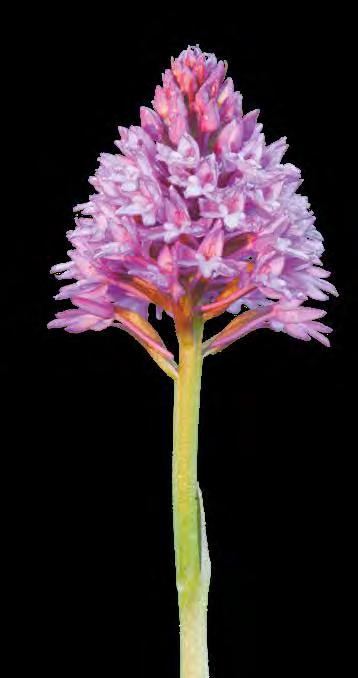

When I started my career in conservation, the ‘Vacancy – warden required to guard rare orchid’ advertisement grabbed my attention. Yes, the job was to guard the only known population of the UK’s rarest orchids in Yorkshire: the lady’s slipper orchid. Yorkshire Wildlife Trust is now raising money to grow it and secure its survival.
Years later I found myself researching the lady’s slipper orchid at Durham Wildlife Trust, when I stumbled across an article describing this orchid in the Trust’s Hawthorn Dene nature reserve. With sadness I read that in 1926 the last of this stunning plant had been picked and given as a gift to a woman by her admirer. UK law now protects wild plants from being picked in this way, but this story is a stark reminder of the fragility of our natural heritage.
Orchids are one of the most diverse groups of plants on the planet. Over 1,000 genera. More than 25,000 species. They are the largest and most highly evolved family of flowering plants.
There are around 57 native orchid species found in Britain (the number varying depending on your source). The
My children say, ‘You’re not allowed favourites!’ This rule applies to orchids and orchid sites as much as anything else in my life. I can’t place one above another - all are special. Allowances are made, with an annual pilgrimage to ‘check in on old friends’. Of orchids, some are work friends and we check how they are doing. A
“Orchids are one of the most diverse groups of plants on the planet.”
number of species is fairly consistent depending on where you live in the country. Hampshire has 30 plus species, Kent and Sussex about 27-28 species each, the same number as the whole of Scotland! Wales has 32. My native Durham and Northumberland have 27 species. Some are common and others really quite rare.


reward for past hard endeavours. Like the early purple orchids that greeted me on a walk through an ancient semi-natural woodland on the Durham coast. In past years, Wildlife Trust volunteers removed non-native trees to allow light to reach the woodland floor to restore the ancient woodland native plant community. Imagine my pleasure on a hot May day as the cool, shaded woodland trail led me to the exact spot. A small flush of early purple orchids bathed in sunlight, accompanied by a chorus of bird song and the trickle of the nearby stream.
The county flower of the Isle of Wight, the pyramidal orchid prefers soils rich Greater butterfly orchid
This walk, I and many Wildlife Trust supporters and colleagues enjoy through spring and summer. Ten orchid species to spot, if you get your timing right.
Endlessly fascinating
Frog orchid (their flowers look like frogs, their hind legs jigging a dance!) rounds off the walk. Every year the same fear fills my head, ‘Where have they all gone?’, then sense prevails and I remember I just need to look a little harder. Down on my hands and knees, I focus on a spot and like a magic-eye picture the hidden forest of frog orchids is revealed.
The Plant Atlas 2020 described this species as potentially the UK’s fastest declining orchid, the decline linked to agricultural improvement, undergrazing and more recently drought.
Climate and weather are important. For the pyramidal orchid, the plant’s basal leaves appear in late autumn and die down the following summer. This growth strategy can leave this orchid vulnerable to climatic differences, with hard cold winters leading to frost damage that jeopardises a plant’s success in the coming spring.
in calcium. Like those of the island, the majority of UK orchids prefer calciumrich soils.
Orchids can produce thousands of very tiny seeds, the greater butterfly orchid producing up to 25,000 seeds per capsule. The fact this sheer number of ultra light seed can be carried by the wind, ensures orchids are able to spread their progeny far and wide. Their success is determined by the environmental conditions they find. If we are to truly restore nature, orchids have many lessons they can teach us. Protecting 30 per cent of land for nature – a commitment made by our government – will mean, in time, some orchid species will find new areas suitable for their growth.
Watching nature reclaim its place in the landscape will be a privilege I thought we may not get to see. But there are examples where people have been doing just that for a number of years.
The dark-red helleborine orchid has been monitored for over 30 years at Bishop Middleham Quarry in County Durham. 2024 was a record year with 3,380 flowering spikes. Surveying at Bishop Middleham is a pleasant late summer’s evening event with longstanding friends and new enthusiasts.
Spare a thought for the orchid surveyors of The Wildlife Trust for Bedfordshire, Cambridgeshire & Northamptonshire. This intrepid group spends three days counting three orchid species; the man (the flower, a human body with an oddly oversized cycle helmet), musk (not smelling of musk, nationally scarce, declined by 70 per cent), and frog orchid… in late winter!
People travel far and wide to see orchids. So it’s nice to finish on a story about orchids that travelled to see people. Recently Essex Wildlife Trust got the opportunity to show off some of their orchids to the King and Queen at the RHS Chelsea Flower Show. ‘Orchids in the Wild – The Beauty of Nature’ showcased the county’s native orchids and the Trust’s important conservation work. The orchids making the journey were common spotted, green-winged, pyramidal and man orchids. I wish I could have seen the effect the VIP’s (very important plants) had on the Royal visitors!
Delicate balance
Orchids highlight just what is at risk if we don’t address the causes of the nature emergency. Orchids have declined like other plants and species. Restoring habitats that support orchids will have benefits for a vast array of other species. Of my much-loved orchid walk the woodland holds three orchid species but is home to hundreds of other plants and animals, not to mention fungi and microorganisms. In the meadow, six orchids make their home amongst herbs and grasses, 44 different species in a metre square.
If you were to do just one thing this spring and summer, make your own orchid story. If you were to do another, ensure the places we should find
Awesome orchids!
Our counties are among the very best for orchids. Orchid season starts in May with the green-winged orchids at Bernwood Meadows, Bucks. June is peak month for a wide range of orchids across many of our reserves, with autumn lady’s-tresses closing the show in August at Greenham Common, Berks.
Find an orchid haven near you and marvel at these masters of mimicry. Head to bbowt.org.uk/ seasonal--spectacles and scroll down to the Summer section.
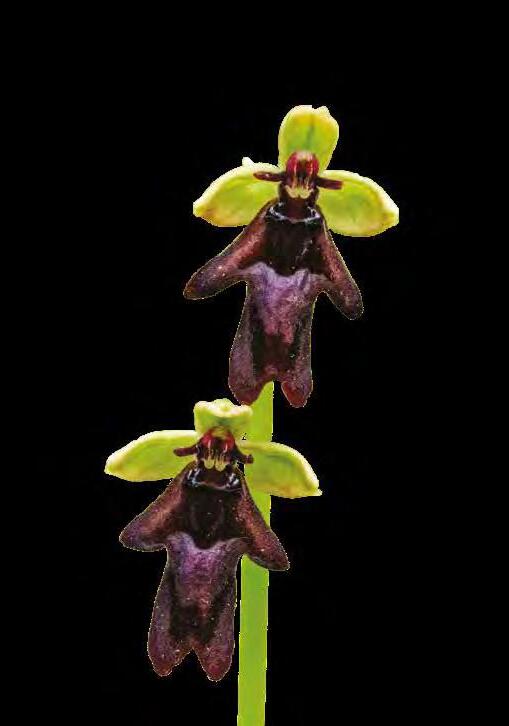
Ophrys insectifera


The first sight of bright lime yellow brimstone butterfly is a signal that spring is on its way. The comma, peacock, red admiral, small tortoiseshell and clouded yellow all make their fragile and fluttering first appearance as winter slips away.
Then each fluttering butterfly will emerge to feed on its favourite wildflowers, while skylarks and pipits fly overhead. The next arrivals are the speckled wood and grizzled skipper, followed by the holly blue, orange tip, painted lady and green veined white. By April on fine sunny days The Wildlife Trusts' nature reserves are coming to life with the beauty of butterflies on the wing. By May a kaleidoscope of butterflies are in flight.
With so many beautiful butterflies and pink, purple and yellow wildflowers on show, prepare to be blown away this spring. Here are six of our best nature reserves for spotting butterflies.
1 Maze Park Nature Reserve, Tees Valley Wildlife Trust


Maze Park is a green oasis right in the centre of Teesside. There is an abundance of herb species, such as yellow-wort and bird’s-foot trefoil which attract more than 12 species of butterfly, including the scarce grayling and dingy skipper.
Where: Thornaby, TS17 6QA
2 Hoe Grange Quarry, Derbyshire Wildlife Trust
The flower-rich short limestone grassland and woodland is a haven for butterflies, with 24 different species recorded. These include comma, peacock, red admiral, small tortoiseshell, speckled wood, orange tip, painted lady, large white and small heath among others. Where: Brassington, DE4 4HX
3 Llanymynech Rocks Nature Reserve, Montgomeryshire & Shropshire Wildlife Trusts
This former limestone quarry is a butterfly hotspot. Its once industrial landscape becomes a riot of wildflowers from spring. Keep your eyes peeled for the dingy and grizzled skippers from April and dark green and silver-washed fritillaries by June. Where: Llanymynech, SY22 6HD
4 Hexton Chalk Pit Nature Reserve, Herts and Middlesex Wildlife Trust
A small, chalk grassland reserve on the north-east Chilterns, colonised naturally by fine-leaved fescue grasses and chalk-loving plants, as well as five species of orchid. The site is a haven for butterflies, including, green hairstreak, dingy skipper, brimstone, peacock, orange-tip and holly blue. Where: Hexton, SG5 3JP
5
Pamber Forest and Upper Inhams
Copse Nature Reserve, Hampshire and Isle of Wight Wildlife Trust
Renowned for its ancient woodland, diverse flora and abundant wildlife, a variety of butterfly species and dragonflies thrive in the reserve's rich habitats. Spot purple emperor, white admiral, speckled wood and brimstone butterfly. Where: Tadley, RG26 3EQ
6 Queendown Warren, Kent Wildlife Trust
Nestled on the outskirts of the Medway towns, this hidden gem provides the perfect habitat for orchids, Kentish milkwort and the adonis blue butterfly, which was reintroduced to the site by Kent Wildlife Trust in 2002. They can often be seen at the site tumbling in the sky with the chalk hill and common blue butterflies.
Where: Sittingbourne, ME9 7XH
Did you spot any butterflies?
We’d love to know how your search went. Please share your best photos with us! See the spectacle for yourself

Dom Higgins, head of health and education at The Wildlife Trusts, explores the sickness of nature disconnect, how the NHS bears the brunt and how The Wildlife Trusts can help with preventable illnesses.
Over 20 million people in the UK have a muscular-skeletal condition such as arthritis or back pain, over 5 million have diabetes. In May 2023 the number of people waiting for an operation was at a record high of 7.3 million – and some are predicting a rise towards 10 million, with one in five people on a hospital waiting list. Long-term sickness is resulting in 2.8 million people of working age being economically inactive. How will the NHS survive?
John from Sheffield had a quadruple heart bypass. He said “I was in a bad way and would have spiralled into being a recluse. I hate to think really. I had PTSD and sleepless nights.” Liz has early stage dementia and couldn’t go anywhere by herself. Just two examples of the longer term recovery from illness and plethora of mental health issues effecting our population today.
But there’s a quiet revolution going on in the world of health and social care, which involves taking part in activities from gardening and woodwork, to wildlife conservation and walks in the park. That’s because many illnesses and ailments are preventable. For example, physical inactivity can cause heart and breathing conditions, while social isolation and loneliness often lead to depression.
A recent highlight in my career was the opportunity to present the findings of The Wildlife Trusts’ report A Natural Health Service at The Lancet UK Public Health Science Conference. The Lancet is a prestigious international medical journal that advances medical science and practice worldwide. The Lancet Conference highlights public health research from the UK and Ireland. I presented evidence showing that ‘green prescribing’ programmes, where GPs and healthcare professionals prescribe time in nature
as treatment and therapy, could have significant benefits. If rolled out to 1.2 million people, these programmes could save the NHS £100 million annually. The public health professionals’ view was that these cost savings were underestimated.
The Sheffield and Rotherham Wildlife Trust’s Wild at Heart programme reduced costs for the NHS associated with the mental health conditions of their 82 participants over a year by £38,646. The project has literally been a lifeline for John and Liz connecting them both to the simple pleasures of nature. Now they have a reason to go out and look forward to walks in the local park, learning about birds and photography.
Over 8,000 people took part in seven Wildlife Trusts’ social prescribing pilots over two years. The pilots were spread across the country with Gwent Wildlife Trust to The Wildlife Trust for Lancashire, Manchester & North Merseyside leading them; and 57% of participants coming from the most economically under-served places and 21% from ethnic minority communities. There were big reductions in anxiety and depression, and big increases in happiness and life satisfaction, alongside an increase in feeling that ‘life is worthwhile.’
Nature prescribing needs to become part of a wider Natural Health Service, one that works hand in hand with the National Health Service.
This is how the NHS will survive.


Dom Higgins is head of health and education at The Wildlife Trusts where he leads their policy and campaigning work in these areas. He is passionate about creating a stronger and more resiliant healthcare system that keeps natural connections at its heart.


Got a keen eye for the perfect shot? Then enter our photo competition!
If you have a passion for wildlife and an eye for detail then our photo competition is for you! Capture nature’s inimitable beauty through the camera lens and share your results – there’s the chance to feature in our 2026 wildlife calendar and some fantastic prizes to be won!
This year we will shortlist up to 10 photos across all entries to go forward for a public vote. The People’s Choice winner will feature on the cover of the calendar.
Prizes to be won!
Our overall winner will win a high-tech bird feeder camera and a fantastic basket of bird-feeding goodies.
There are lots more exciting prizes to be announced! Please check the competition webpage for details.
Submit up to four photographs across eight categories:
1. Children and Teens
2. Nature on Your Doorstep
3. Mobile Phone Photography 4. Birds
5. Butterflies and Other Insects
6. BBOWT Nature Reserves
7. Mammals and Other Animals
8. Flowers and Fungi


